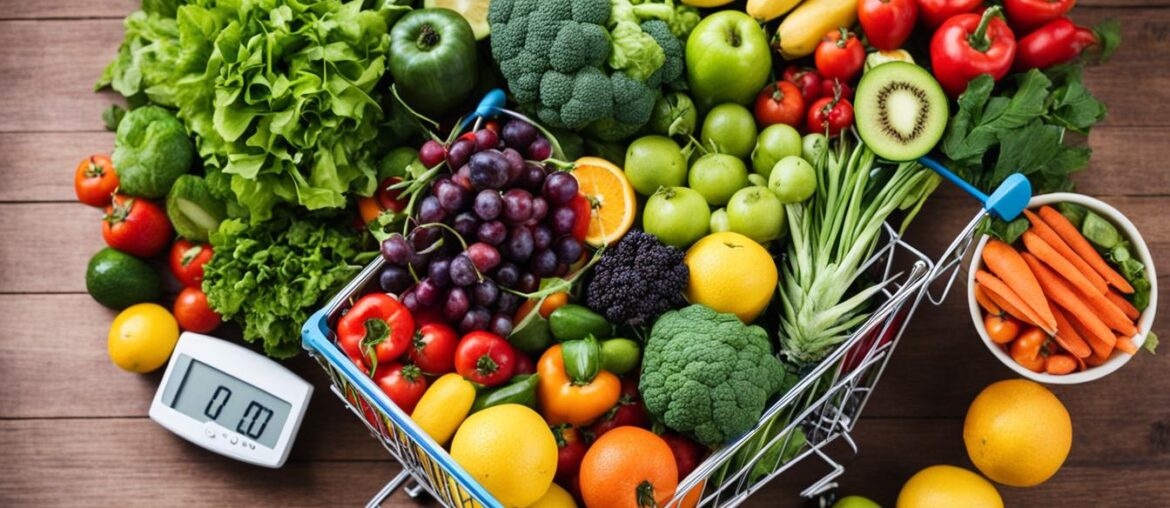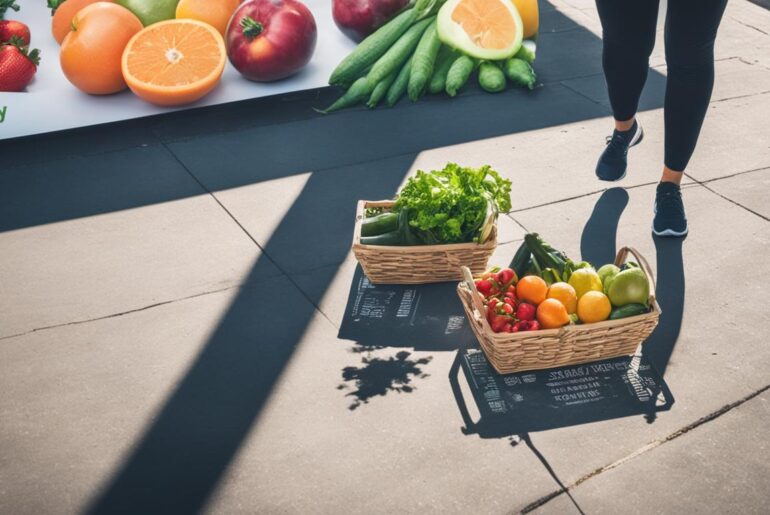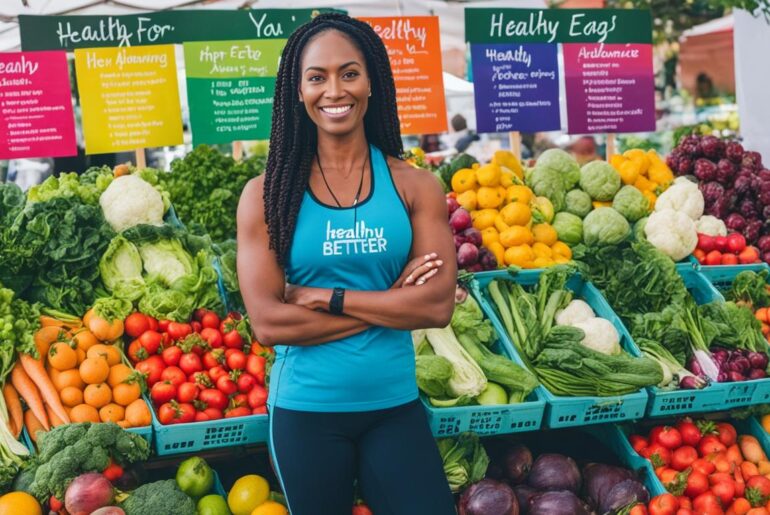When it comes to weight loss, a trip to the grocery store can either make or break your progress. I’m here to share some smart grocery shopping tips that will help you make healthier choices and support your weight loss goals.
First and foremost, it’s important to be prepared with the right foods. Before heading to the store, take inventory of your pantry and fridge to see what staple items you already have. This will help you avoid buying duplicates and stay organized.
Next, make a list of the items you need. By having a shopping list, you can stay focused and minimize impulse purchases. Plan your meals for the week and include ingredients that fit within your weight loss diet.
When you’re at the store, try to shop the perimeter where the fresh produce, lean proteins, and dairy products are located. These areas typically have the healthiest options. Avoid spending too much time in the aisles where processed and sugary foods are displayed.
One important tip is to never go grocery shopping on an empty stomach. When we’re hungry, we tend to make unhealthy choices and give in to cravings. Eat a nutritious meal or snack before you head to the store to help you make better decisions.
Lastly, take the time to read nutrition labels. They provide valuable information about serving sizes, calories, and the ingredients used. By understanding what’s in the products you’re buying, you can make informed decisions and choose the healthier options.
Key Takeaways:
- Be prepared by taking inventory before you go shopping.
- Create a shopping list based on your weight loss meal plan.
- Shop the perimeter of the store for fresh, healthy options.
- Avoid shopping on an empty stomach to prevent impulse purchases.
- Read nutrition labels to make informed choices.
Meal Planning for Weight Loss
Meal planning plays a crucial role in achieving successful weight loss. By utilizing a meal planner, you can effectively guide your grocery shopping and ensure that you are making healthy and portion-controlled choices. Building your meals around lean proteins, plenty of vegetables, whole grains, and healthy fats will provide you with the necessary nutrients and help you maintain a balanced diet.
Preparing your meals in advance allows you to control portion sizes and eliminate the temptation of unhealthy options. With a well-planned meal calendar, you can avoid impulsive food decisions and stay on track with your weight loss goals. By incorporating meal planning into your routine, you save time, money, and unnecessary stress throughout the week.
“Meal planning is the foundation of a successful weight loss journey. It empowers you to have control over your meals and ensures that you are consistently making nutritious choices.”
Benefits of Meal Planning
- Consistent portion control for weight management.
- Efficient use of time and resources.
- Reduces the risk of impulsive, unhealthy food choices.
- Supports a balanced diet with adequate nutrition.
- Encourages sustainable and long-term healthy eating habits.
By planning your meals in advance, you can take advantage of the many benefits meal planning offers. To get started, select a meal planner that suits your preferences, whether it’s a physical notebook, smartphone app, or online tool. Begin by identifying your dietary needs and goals, such as calorie intake, macronutrient distribution, or specific dietary restrictions.
Once you have determined your requirements, create a weekly meal plan that includes a variety of nutrient-rich foods. Incorporate lean proteins like chicken, fish, tofu, or legumes, along with an assortment of colorful vegetables. Include whole grains such as quinoa, brown rice, or whole-wheat pasta to provide fiber and energy. Don’t forget to add healthy fats like avocado, olive oil, or nuts to enhance your meals’ satiety and flavor.
With your meal plan completed, you can now generate a comprehensive grocery list that aligns with your planned meals. This ensures that you have all the necessary ingredients readily available, making cooking and eating healthier much more convenient.
| Meal | Protein | Vegetables | Whole Grains | Healthy Fats |
|---|---|---|---|---|
| Monday Lunch | Grilled chicken breast | Mixed greens, cherry tomatoes | Quinoa | Olive oil |
| Tuesday Dinner | Salmon | Steamed broccoli, carrots | Brown rice | Avocado |
| Wednesday Lunch | Tofu | Sautéed bell peppers, zucchini | Whole-wheat pasta | Walnuts |
| Thursday Dinner | Lean ground turkey | Roasted Brussels sprouts, sweet potatoes | Cauliflower rice | Coconut oil |
By practicing meal planning for weight loss, you can take control of your diet and ensure that you are nourishing your body with the right foods in the right amounts. With a clear plan in place, you can save time, reduce stress, and make healthier choices that support your weight loss journey.
Shop Mindfully for Weight Loss
When grocery shopping for weight loss, it’s important to shop mindfully. By adopting mindful eating habits and making thoughtful food choices, you can support your weight loss goals and improve your overall health. Here are some strategies to help you shop mindfully:
Avoid Impulsive Purchases
One of the key aspects of mindful shopping is avoiding impulsive purchases. It’s easy to get tempted by the brightly packaged, processed foods that claim to be quick and convenient. However, these foods are often high in sugar, sodium, and unhealthy fats, which can hinder your weight loss progress. Instead, focus on choosing whole foods that are packed with nutrients and support your well-being.
Choose Nutritious Whole Foods
When shopping for weight loss, prioritize nutritious whole foods. These include fruits, vegetables, lean proteins, and whole grains. Incorporating a variety of these foods in your meals can provide the necessary nutrients, fiber, and protein to keep you satisfied and promote weight loss. Look for weight loss recipes that incorporate these ingredients to create balanced meals that are both delicious and nourishing.
Read Nutrition Labels
Reading nutrition labels is another important aspect of mindful shopping. Take the time to review the labels of the foods you’re considering buying. Pay attention to serving sizes, calories, fat, sugar, sodium, and ingredient lists. This will help you make informed choices and select foods that align with your weight loss goals. Remember, knowledge is power, and understanding nutrition labels empowers you to make healthier choices.
“It’s essential to shop mindfully and be aware of the foods you’re purchasing. Focus on choosing nutrient-dense foods that nourish your body and support your weight loss journey.” – Emily Smith, Nutritionist
Mindful Eating Grocery List
This table provides a sample grocery list for mindful eating and weight loss. These foods are packed with nutrients and can help you create nourishing meals that support your health and weight loss goals.
| Fruits and Vegetables | Lean Proteins | Whole Grains | Healthy Fats |
|---|---|---|---|
| Apples | Skinless Chicken Breast | Quinoa | Avocado |
| Berries | Turkey Breast | Brown Rice | Nuts (almonds, walnuts) |
| Leafy Greens (Spinach, Kale) | Salmon | Whole Wheat Bread | Olive Oil |
| Carrots | Eggs | Oats | Coconut Oil |
Plan Ahead and Save Money
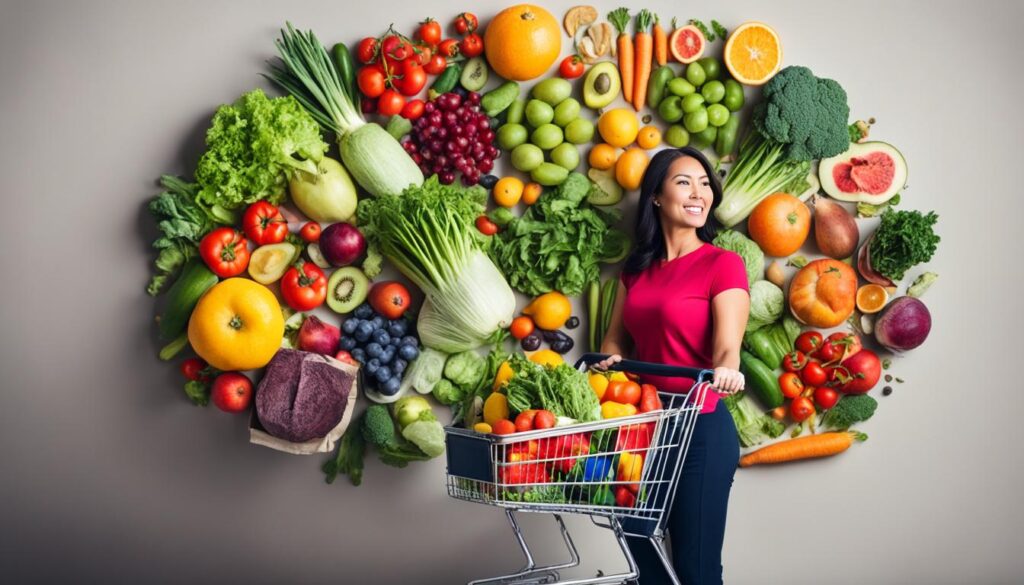
Planning your meals ahead of time can be a game-changer for both your budget and your weight loss goals. By taking a proactive approach to grocery shopping, you can save money, reduce food waste, and make healthier choices along the way.
Create a Meal Plan and Grocery List
One of the best ways to plan ahead is by creating a meal plan for the week. This involves deciding what meals you’ll have for breakfast, lunch, dinner, and snacks. By having a clear plan, you’ll know exactly what ingredients you need to buy and avoid purchasing unnecessary items.
Once you have your meal plan, make a grocery list based on the ingredients you’ll need. This list will serve as your roadmap when you go shopping and help you stay on track. Stick to your list as much as possible to avoid impulse purchases that can derail your budget and healthy eating goals.
Take Advantage of Sales and Coupons
To maximize your savings, keep an eye out for sales and coupons. Many grocery stores offer weekly or monthly promotions on various items. Take the time to browse through store flyers or check their websites for the latest deals. By planning your meals around these discounted products, you can save money while still enjoying nutritious meals.
In addition to sales, utilize coupons to further reduce your grocery expenses. Look for coupons in newspapers, online coupon websites, or store loyalty programs. Combining coupons with sale items can result in significant savings. Just make sure to only use coupons for products you actually need or regularly consume.
Shop in Bulk and Freeze
Buying in bulk can be a cost-effective way to stock up on staple ingredients. Items like rice, beans, pasta, nuts, and seeds are often available in larger quantities at lower prices. These pantry staples have a long shelf life and can be used in a variety of recipes, making them a great investment for your wallet and your health.
Additionally, when you have the opportunity to buy fresh produce in bulk at a discounted price, consider freezing some for later use. Freezing fruits and vegetables preserves their nutrients while allowing you to use them in smoothies, stir-fries, or soups even when they’re out of season.
Tips for Saving Money on Grocery Shopping
| Tips | Description |
|---|---|
| Meal planning | Create a weekly meal plan to guide your grocery list and avoid unnecessary purchases. |
| Sales and coupons | Take advantage of sales and coupons to save money on grocery items. |
| Buy in bulk | Purchase pantry staples in larger quantities to save money in the long run. |
| Freezing produce | Freeze fresh fruits and vegetables to extend their shelf life and reduce waste. |
By implementing these tips into your grocery shopping routine, you can make healthy choices while keeping your budget intact. With proper planning, you’ll be able to save money, reduce waste, and stay on track with your weight loss journey.
Avoid Shopping on an Empty Stomach
When it comes to grocery shopping for weight loss, it’s important to make smart choices and avoid unnecessary temptations. One of the most effective strategies is to avoid shopping on an empty stomach. Here’s why:
Shopping for groceries when you’re hungry can lead to impulsive purchases of high-calorie, unhealthy foods. When your stomach is growling, it’s more difficult to resist the temptation of indulgent snacks and treats that may derail your weight loss goals. By eating a satisfying meal before heading to the store, you can make better choices and stick to your shopping list.
In case you find yourself shopping on an empty stomach, there are a few tricks you can use to curb your hunger:
- Drink water: Staying hydrated can help suppress your appetite. Keep a refillable water bottle with you to sip on while you shop.
- Snack on a piece of fruit: Choose a piece of fruit, such as an apple or a banana, to provide a healthy and filling snack that won’t derail your weight loss efforts.
By taking steps to avoid shopping on an empty stomach, you can stay focused on your weight loss strategies and make healthier choices for your overall well-being.
| Benefits of Avoiding Shopping on an Empty Stomach | Tips to Curb Hunger |
|---|---|
|
|
Read Nutrition Labels for Weight Loss

When it comes to weight loss, understanding nutrition labels is crucial for making informed choices during grocery shopping. By paying close attention to key information such as serving sizes, calories, fat, cholesterol, and sodium, you can select healthier food options that align with your weight loss goals.
Nutrition labels provide valuable insights into the nutritional content of a product, allowing you to compare similar items and make the best choices for your health. Don’t be swayed by claims like “low-fat” or “fat-free” as these products can still be high in calories. By comparing different options, you can find the product that offers the optimal balance between taste and nutrition.
Let’s take a closer look at the key elements you should focus on when reading nutrition labels:
- Serving Sizes: Pay attention to the serving size indicated on the label as it affects the number of calories and nutrients you consume. Be mindful of portion sizes to prevent overeating.
- Calories: The calorie count shows the amount of energy provided by a serving of the product. Opt for food items with lower calorie counts to support your weight loss efforts.
- Fat: Keep an eye on the fat content, especially saturated and trans fats, as they can contribute to weight gain and increase the risk of heart disease. Choose products with lower fat content or opt for healthier fats such as monounsaturated and polyunsaturated fats.
- Cholesterol: High cholesterol levels can negatively impact heart health. Limit your intake of cholesterol by selecting low-cholesterol options.
- Sodium: Excessive sodium consumption can lead to high blood pressure. Look for products with lower sodium content to support a healthy diet.
By becoming familiar with nutrition labels and understanding how to interpret the information provided, you empower yourself to make smarter and more mindful choices while grocery shopping. These small but impactful decisions can make a significant difference in your weight loss journey.
“I always make it a point to read nutrition labels when grocery shopping for my weight loss journey. It helps me make informed decisions and choose healthier options that align with my goals.”
– Laura K.
Key Nutritional Information to Consider
| Nutrient | Importance | Recommended Intake | Sources |
|---|---|---|---|
| Calories | Energy provided by food | Varies based on individual needs | Carbohydrates, proteins, fats |
| Fat | Energy source, essential nutrients | 25-35% of total calories | Olive oil, avocados, nuts, fatty fish |
| Cholesterol | Structural component of cells | Less than 300 mg per day | Egg yolks, organ meats |
| Sodium | Essential mineral, electrolyte balance | Less than 2,300 mg per day | Salt, processed foods |
| Vitamins and Minerals | Essential for various bodily functions | Varies based on specific nutrient | Fruits, vegetables, whole grains |
By referring to this table, you can gain a better understanding of the importance of various nutrients and their recommended intake. This knowledge can guide you in making nutritious choices while grocery shopping, supporting your weight loss goals.
Build a Balanced Grocery List
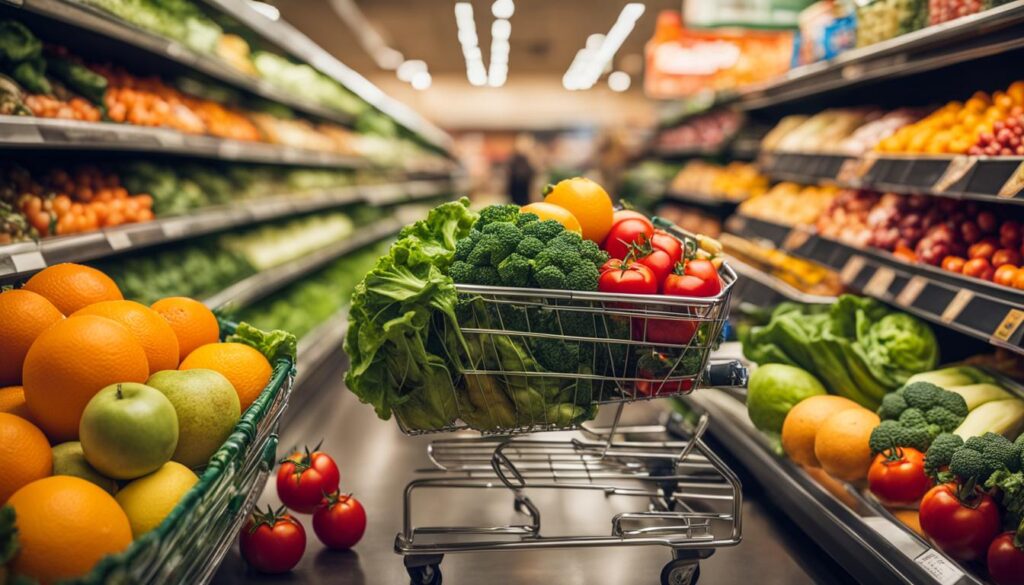
When it comes to successful weight loss and maintaining a healthy eating routine, one of the key factors is having a well-planned grocery list. By focusing on building a balanced diet, you can ensure that your meals are nutritious and support your weight loss goals.
When creating your weight loss grocery list, consider including a variety of:
- Fruits
- Vegetables
- Lean proteins
- Whole grains
- Healthy fats
- Low-fat dairy products or dairy alternatives
By incorporating these food groups into your grocery list, you can create a well-rounded meal plan that provides essential nutrients and promotes healthy eating habits (check out my post on healthy eating habits here). Including a variety of fruits and vegetables ensures that you get a range of vitamins, minerals, and antioxidants, while lean proteins and whole grains provide a satisfying source of energy.
Including healthy fats, such as avocados, nuts, and olive oil, in moderation, can contribute to a balanced diet. For those who prefer dairy products or dairy alternatives, options like low-fat yogurt or almond milk can be included on the grocery list.
| Food Group | Examples |
|---|---|
| Fruits | Apples, bananas, berries, citrus fruits |
| Vegetables | Leafy greens, broccoli, bell peppers, carrots |
| Lean proteins | Chicken breast, turkey, tofu, fish |
| Whole grains | Brown rice, quinoa, whole wheat bread, oats |
| Healthy fats | Avocados, nuts, olive oil |
| Low-fat dairy products or dairy alternatives | Low-fat yogurt, almond milk |
By following a balanced grocery list, you can ensure that your meals are not only nutritionally rich but also enjoyable. Meal planning with these ingredients will help you create satisfying and flavorful meals while supporting your weight loss journey.
Building a balanced grocery list is an essential step towards achieving your weight loss goals. Remember to consider your personal preferences and dietary restrictions when creating your list. With a well-planned grocery list, you can embark on a healthy and sustainable eating journey.
Stock Up on Fresh Produce

Fresh produce plays a vital role in successful weight loss grocery shopping. Not only are fruits and vegetables low in calories, but they are also high in fiber, making them filling and nutritious choices for your meals. To ensure a variety of flavors and nutrients, it’s important to stock up on a range of fresh fruits and vegetables.
When it comes to weight loss, incorporating different types of fruits and vegetables into your diet can help keep your meals interesting and satisfying. Some examples of nutritious produce to include in your shopping list are:
- Apples – A crunchy and fiber-rich fruit that can help curb cravings
- Avocados – A creamy and nutrient-dense fruit packed with healthy fats
- Bananas – A versatile and potassium-rich fruit that can provide sustainable energy
- Berries – Colorful and antioxidant-rich fruits that add a burst of flavor
- Citrus fruits – Vitamin C-packed fruits like oranges, lemons, and grapefruits
- Leafy greens – Nutrient-dense greens such as spinach, kale, and lettuce
By including these fresh produce options in your weight loss grocery shopping, you’ll be able to create a wide variety of meals that are both nutritious and delicious. Experiment with different combinations and cooking methods to keep your meals exciting and enjoyable.
Choose Nutrient-Rich Foods
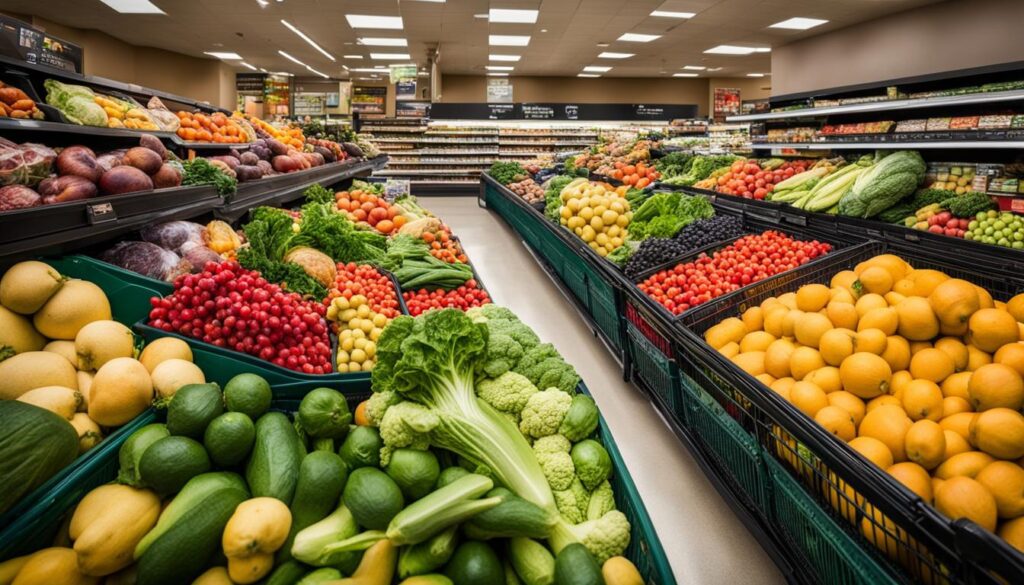
When it comes to weight loss grocery shopping, one of the key factors to consider is choosing nutrient-rich foods. These are foods that are packed with essential vitamins, minerals, and antioxidants that can support your overall health and weight loss goals.
Opting for lean proteins is a great first step. Lean proteins such as skinless chicken breast, turkey, fish, tofu, and beans provide the necessary building blocks for maintaining and repairing your body’s tissues. They also help to keep you feeling fuller for longer, reducing the likelihood of snacking on unhealthy foods.
Whole grains are another important component of a nutrient-rich diet. Quinoa, brown rice, whole wheat bread, and oats are all excellent choices. These grains offer a good source of fiber, which aids in digestion and helps to regulate blood sugar levels. Fiber also helps you feel satisfied after a meal, preventing overeating.
Incorporating nuts and seeds into your diet is also beneficial for weight loss. These small powerhouses are packed with healthy fats, fiber, and protein. Almonds, walnuts, chia seeds, and flaxseeds are all great options. They not only provide essential nutrients but also help to promote heart health and reduce inflammation.
Don’t forget about healthy fats! Avocados, olive oil, and coconut oil are all rich sources of monounsaturated fats, which are known to support heart health and aid in weight loss. These fats are also incredibly satiating, keeping you satisfied and preventing mindless snacking.
Here’s a table highlighting some nutrient-rich food options for weight loss:
| Food Group | Examples |
|---|---|
| Lean Proteins | Skinless chicken breast, turkey, fish, tofu, beans |
| Whole Grains | Quinoa, brown rice, whole wheat bread, oats |
| Nuts and Seeds | Almonds, walnuts, chia seeds, flaxseeds |
| Healthy Fats | Avocados, olive oil, coconut oil |
By choosing nutrient-rich foods, you can ensure that you’re providing your body with the essential nutrients it needs while promoting weight loss. These foods not only support your overall health but also keep you feeling satisfied, making it easier to stick to your weight loss goals.
:Which groceries should I buy to follow a low-carb or ketogenic diet for weight loss?
When choosing groceries for a lowcarb vs ketogenic comparison, focus on high-fat, low-carb items. Avocados, olive oil, and fatty cuts of meat are great for a ketogenic diet, while adding leafy greens, nuts, and seeds can provide more flexibility for a low-carb approach. Stick to unprocessed, natural foods for best results.
Get Support for Weight Loss

Embarking on a weight loss journey can sometimes feel overwhelming, but you don’t have to go it alone. Having a strong support system can make a significant difference in your success. Surrounding yourself with people who share your goals and aspirations can provide the motivation and accountability you need to develop healthy habits and achieve your weight loss goals.
There are various ways to find weight loss support and establish a network of individuals who can provide guidance and encouragement along the way:
- Join an online forum: Online weight loss communities can be a valuable resource for support and information. Connect with like-minded individuals who are going through similar journeys and share advice, progress, and tips for staying on track.
- Share your goals with friends or family: Opening up about your weight loss aspirations to close friends or family members can create a network of support in your immediate circle. They can offer encouragement, help keep you accountable, and celebrate your achievements.
- Participate in a weight loss program: Joining a structured weight loss program can provide comprehensive support, personalized guidance, and access to tools and resources designed to help you reach your goals. These programs often include support groups, coaching, meal plans, and fitness plans tailored to your needs.
Remember, having a support system is not just about finding motivation; it’s about creating a positive environment that fosters healthy habits and encourages sustainable change. By connecting with others on the same journey, you can share experiences, seek advice, and celebrate successes together.
Stay Accountable and Motivated
In addition to providing support, your weight loss support system can help keep you accountable and motivated. Sharing your progress, challenges, and victories with others can make you more driven to stick to your healthy habits.
“Surrounding yourself with positive and supportive individuals can be the key to maintaining healthy habits and achieving long-term weight loss success.” – Dr. Amanda Peterson, Weight Loss Specialist
By staying connected and actively participating in your weight loss support network, you are more likely to stay committed and focused on your goals. Regularly engaging with others who understand your journey can help you navigate obstacles, share strategies, and find inspiration when you need it most.
So, don’t underestimate the power of a strong support system. Reach out, connect with others, and build a network of individuals who will cheer you on, provide guidance, and help you develop healthy habits that will support your weight loss journey.
Conclusion
Grocery shopping plays a crucial role in weight loss. By implementing these smart strategies, you can optimize your shopping experience and make healthier choices. Planning ahead and creating a detailed grocery list will help you stay focused and avoid impulse purchases that may derail your weight loss goals.
Reading nutrition labels is essential for making informed decisions. It allows you to choose foods that align with your weight loss objectives. Additionally, shopping the perimeter of the store and prioritizing fresh produce and nutrient-rich foods will provide your body with the necessary nutrients while keeping your calorie intake in check.
Remember, achieving lasting weight loss requires consistency and sustainable changes. By incorporating these weight loss tips into your grocery shopping routine, you’ll be on your way to a healthier lifestyle and the results you desire. Start implementing these strategies today and take control of your journey towards a healthier you.

